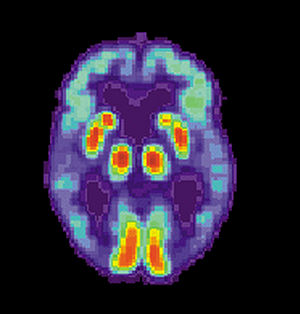A tiny piece of a critical receptor that fuels the brain and without which sentient beings cannot live has been discovered by University at Buffalo scientists as a promising new drug target for Alzheimer’s and other neurodegenerative diseases.
The research on the NMDA (N-methyl-D-aspartate) receptor is being published online Oct. 11 in Nature Communications.
“This is the first time that this site has been shown to be useful as a drug target,” says Gabriela K. Popescu, PhD, associate professor of biochemistry in UB’s School of Medicine and Biomedical Sciences and senior author on the study.
“If we could find a drug that attaches itself to this site and locks together NMDA receptor subunits, that would be huge for fighting disability from stroke and Alzheimer’s and other neurodegenerative diseases.”
The research focuses on the brain’s receptors for the neurotransmitter, glutamate, which is implicated in these diseases as well as in other conditions, such as glaucoma.
The two main glutamate receptors in the brain are NMDA and AMPA receptors, both of which play critical roles in human learning and memory. Both types of receptors are made of four subunits and within each receptor these subunits are organized in pairs called dimers.
Because these receptors are so similar in structure, Popescu explains, it was assumed that they function in much the same way.
“But when we altered the dimer interface, the site where two subunits come together within each pair, we found that the NMDA receptor works just the opposite of the way that the AMPA receptor works,” Popescu explains. “Cementing this interface in AMPA receptors leads to more activity, whereas we found just the opposite to be true in NMDA receptors.”
By locking the subunits together, the UB researchers were able to achieve a marked reduction in NMDA activity and, subsequently, a marked reduction in the amount of calcium that enters neurons in response to the neurotransmitter glutamate. Calcium overload due to overactive NMDA receptors is what eventually kills off neurons, Popescu explains, leading to the symptoms that occur after a stroke, and in Alzheimer’s and other neurodegenerative diseases.
“The fact that by cross-linking the subunits, we could so dramatically reduce NMDA receptor activation demonstrates, for the first time, the tantalizing possibility that we may be able to develop new therapies that can much more effectively treat, or even one day prevent, some of these devastating diseases, like Alzheimer’s and stroke,” says Popescu.
And, because each type of NMDA receptor has a slightly different dimer interface, Popescu explains, this finding represents a new opportunity for rationally designing drugs that would preferentially inhibit only a select population of NMDA receptors in the brain, thus reducing the possibility of side effects.
Currently, the Alzheimer’s drug called Namenda, one of the only existing pharmaceuticals that inhibit the NMDA receptor, targets a different site within the receptor.
Read more . . .
Bookmark this page for “New Drug Target” and check back regularly as these articles update on a very frequent basis. The view is set to “news”. Try clicking on “video” and “2” for more articles.








